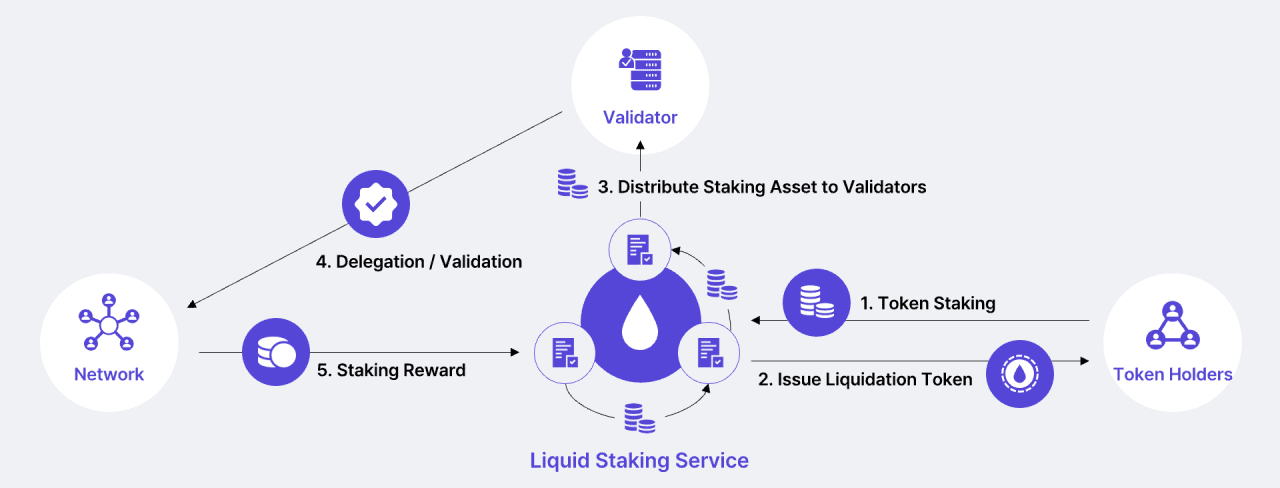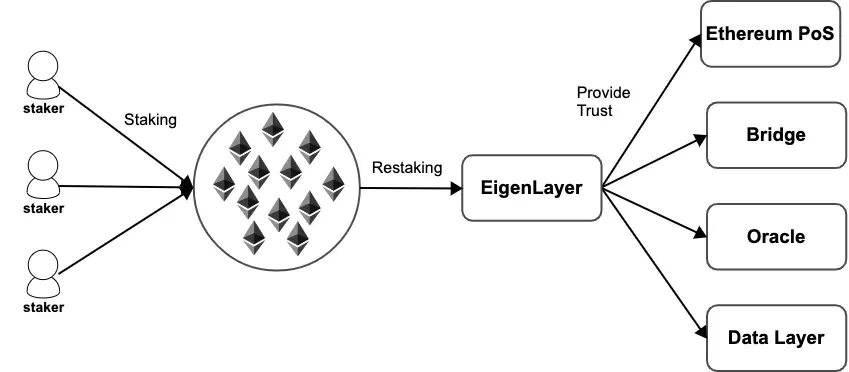Restaking: A Strategy to Boost Capital Efficiency

April 2023 marked a pivotal update in the Ethereum blockchain with Shapella (Shanghai + Capella), enabling the withdrawal of ETH from staking. This innovation gave rise to restaking, a method that allows locked ETH to be utilized both within the Ethereum main network and across various protocols.
As we stepped into March 2024, the Total Value Locked (TVL) in Ethereum's restaking sphere had hit $12 billion. This mechanic is spearheaded by EigenLayer, which stands as Ethereum's pioneering and most significant restaking protocol.

The mechanism of restaking is akin to constructing a house of cards, layering multiple elements on a foundational piece. To grasp its intricacies, let's delve into the core principles of traditional and liquid staking.
Entering the fray as a validator in Ethereum requires a hefty sum of 32 ETH (valued at $114,000 as of March 2024), a steep barrier for many. This challenge birthed liquid staking protocols as a solution.


Let’s unpack restaking with a relatable analogy.
An intriguing development in this space is automatic restaking. Platforms like Ether.fi automate the addition of ETH into liquid staking, awarding users with a liquid staking token (eETH), which is then becomes slated for restaking through EigenLayer. Although this process simplifies engagement, it’s essentially a subset of liquid restaking due to its reliance on LST.
Moreover, restaking poses a conceptual risk to the Ethereum network’s overall security. Vitalik Buterin, the blockchain's founder, has voiced concerns that incentivizing validator rewards through such schemes could erode the blockchain’s social consensus—where validation is premised on external events beyond the blockchain.
As the domain of restaking is still unfolding, it’s plausible that future innovations will introduce even more refined solutions. For crypto enthusiasts keen on leveraging these developments, staying informed and adaptive is crucial.
Keep up with our blog on X to stay updated on the latest in the crypto world!

Ethereum's Restaking TVL. Source: defillama.com
The restaking phenomenon isn't confined to Ethereum alone; it's also taking root in blockchains such as Solana (via Picasso Finance), Near (Octopus Network), and Cosmos (Persistence). These platforms integrate seamlessly with other protocols (like Lido and Jito), forming the backbone of the restaking infrastructure.
The mechanism of restaking is akin to constructing a house of cards, layering multiple elements on a foundational piece. To grasp its intricacies, let's delve into the core principles of traditional and liquid staking.
Traditional and Liquid Staking
In September 2022, Ethereum transitioned from Proof-of-Work to Proof-of-Stake. This shift allowed network participants to stake ETH, serving as a pledge of security and integrity for validators. Misconduct could lead to slashing, forfeiting the staked ETH.
Entering the fray as a validator in Ethereum requires a hefty sum of 32 ETH (valued at $114,000 as of March 2024), a steep barrier for many. This challenge birthed liquid staking protocols as a solution.

The Mechanism of Liquid Staking Services. Source: linkedin.com
Liquid staking democratizes the staking process, enabling any amount of ETH to be staked through intermediaries: Lido for Ethereum, Jito for Solana, and so forth. In exchange, participants receive tokens equivalent to their staked ETH (stETH, rETH, JitoSOL), symbolizing ownership of the staked assets (ETH, SOL) and their utility across other dApps.
What is Restaking?
Historically, staked tokens were confined to their native Ethereum network. With the advent of restaking, these tokens have taken on a dual role: fortifying the security of Ethereum and extending their utility to other dimensions like cross-chain bridges, oracles, and data availability layers.

The Fundamentals of Restaking. Source: obvious.technology
The predominant model for restaking hinges on the integration of Liquid Staking Tokens (LST) within protocols like EigenLayer. Here’s the step-by-step:
- Users stake ETH in a liquid staking protocol, such as Lido, receiving an equivalent amount of LST (for Lido, this is stETH).
- These LSTs are then channeled into the restaking protocol, EigenLayer.
- Within EigenLayer, users pinpoint and select from an array of AVS (Actively Validated Services) services or protocols needing security bolstering.
Let’s unpack restaking with a relatable analogy.
Imagine ETH as a textbook required for acing a math exam. You take this book to the city library (a liquid staking protocol, such as Lido), which in turn allows its readers (the Ethereum network) to benefit from the resource, charging a fee (staking rewards) for its use. As the book's owner, you reap a portion of the transactional profits.
Upon submitting your book, the librarian scans it and hands you a copy (stETH), verifying your entitlement to rewards and ownership. With this copy, you head over to a school library (EigenLayer), which lends it to a classroom (an AVS). The class benefits from the book copy, and you're rewarded in return.
Thus, the school library embodies the restaking protocol—a platform leveraging liquid staking tokens (the book copies from the city library). Each classroom represents an AVS, allowing you the autonomy to decide where your copies are utilized.
Restaking Types:
- Native Restaking: Employs ETH that’s locked in the Beacon Chain, leveraging Ethereum's Proof-of-Stake mechanism.
- Liquid Restaking: Engages liquid staking tokens such as stETH by Lido, rETH by Rocket Pool, and cbETH by Coinbase, among others.
- LP (Liquidity Provider) Restaking: Here, users first stake ETH via liquid staking platforms, lock the resulting LST in dApps, and subsequently restake the LP tokens, which represent the assets added to the dApps.
An intriguing development in this space is automatic restaking. Platforms like Ether.fi automate the addition of ETH into liquid staking, awarding users with a liquid staking token (eETH), which is then becomes slated for restaking through EigenLayer. Although this process simplifies engagement, it’s essentially a subset of liquid restaking due to its reliance on LST.
The Perils of Restaking
Restaking’s appeal lies in its capacity to put available ETH to work across user-selected AVS, enhancing potential returns from ETH holdings.
However, this layered engagement in restaking—from committing ETH to a liquid staking protocol, which then stakes in the primary ETH network, to further staking the acquired LST in EigenLayer, and subsequently across various AVS—introduces a complex web of risks. A security mishap at any stage can unravel the entire construct.
However, this layered engagement in restaking—from committing ETH to a liquid staking protocol, which then stakes in the primary ETH network, to further staking the acquired LST in EigenLayer, and subsequently across various AVS—introduces a complex web of risks. A security mishap at any stage can unravel the entire construct.
The multilayered nature of restaking introduces several layers of risk:
- The fundamental risks associated with staking ETH.
- Risks linked to the liquid staking protocol in use.
- Risks specific to restaking ETH.
- Security vulnerabilities of the AVS being utilized.
Moreover, restaking poses a conceptual risk to the Ethereum network’s overall security. Vitalik Buterin, the blockchain's founder, has voiced concerns that incentivizing validator rewards through such schemes could erode the blockchain’s social consensus—where validation is premised on external events beyond the blockchain.
Given the variance in rewards across AVS, there’s a temptation for validators to gravitate towards services offering the most attractive APR (Annual Percentage Rate). This scenario could lead to an unhealthy concentration of stakers in a singular protocol, inadvertently leading to the centralization of the blockchain.
Wrapping Up
Restaking marks a significant step forward in amplifying the utility of ETH, prompting a shift in capital management strategies among some users. Moving away from stablecoins, these individuals are now leaning towards purchasing and restaking ETH, thereby maintaining an active market presence while enhancing their ETH reserves.
As the domain of restaking is still unfolding, it’s plausible that future innovations will introduce even more refined solutions. For crypto enthusiasts keen on leveraging these developments, staying informed and adaptive is crucial.
Keep up with our blog on X to stay updated on the latest in the crypto world!


